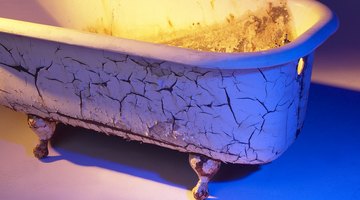How to Repair a Cast Iron Crack Without Welding
Cast iron is used in many household and industrial structures. Cast iron is by nature brittle and can be susceptible to cracks and breaks. Large swings in temperature, thermal gradients and physical shocks such as drops can cause cracks.

Cast iron can be repaired using welding techniques, but this is difficult and can cause further damage. Brazing, a technique that uses less heat than welding, is often used to repair cracks in cast iron pieces.
-
Choose a filler rod. A filler rod is chosen based on the application of the cast iron part. Filler rods used for cast iron brazing are often made from nickel or brass. Some fabricators use filler rods that contain flux, while others prefer to use a separate flux during the brazing process.
-
Prepare the surface of the crack. The crack in the cast iron part has to be cleaned and prepared prior to brazing to remove surface impurities and oxides. The crack should be ground out using a grinder to form a U-shaped cross-section. This allows the brazing material to fully flow into the crack and avoid stress concentrations.
-
After grinding, brush the ground area using a stainless steel brush. This step will remove all particulates left over from the grinding process.
-
Heat the cast iron part. If a brazing torch is used on a cold part, further cracking and warping can occur, so a heat source such as a gas grill, weed burner or oven can be used to slowly heat the cast iron part.
-
Place the cast iron piece onto a work surface and brace it if needed. Some large parts may require heating during the brazing process, particularly if the crack is large and the brazing process will take time. Use an external heater to maintain the temperature of the piece.
-
Use a brazing torch to heat the surfaces of the crack until they turn bright red. Touch the filler rod to the crack surface: the surface temperature should be hot enough to cause the filler rod material to flow into the crack. Use the torch to maintain the local temperature while progressing down the crack.
-
Put the repaired part into a container of sand and completely cover the part with the sand. After brazing, repaired cast iron parts must be cooled very slowly. If a part is left out in air to cool, it can crack. Leave the part in the sand for at least one day, longer if the part is large.
- Filler rod
- Grinder
- Stainless steel brush
- Brazing torch
- Flux (if filler rod does not contain flux)
- Heat source
- Container of sand
Things You Will Need
Warning
Always use protective equipment when brazing or welding, including gloves, coveralls and eye protection
References
Warnings
- Always use protective equipment when brazing or welding, including gloves, coveralls and eye protection
Writer Bio
Susan Kristoff has been writing engineering content for 13 years. Her articles have appeared on eHow.com, Suite101, her personal websites, and the websites of many ghostwriting clients. Kristoff's expertise includes design, structures, sensors, data acquisition, and fabrication.
Photo Credits
- Hemera Technologies/AbleStock.com/Getty Images
- Hemera Technologies/AbleStock.com/Getty Images
More Articles



